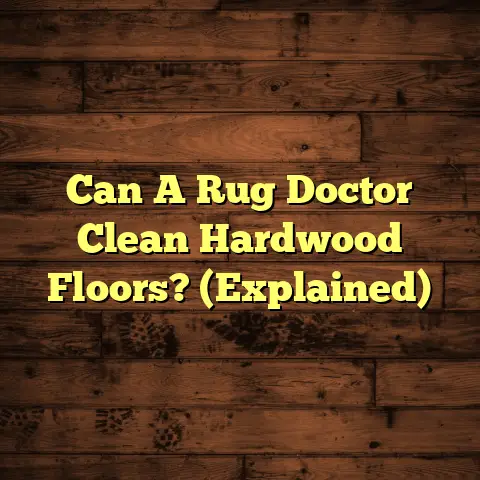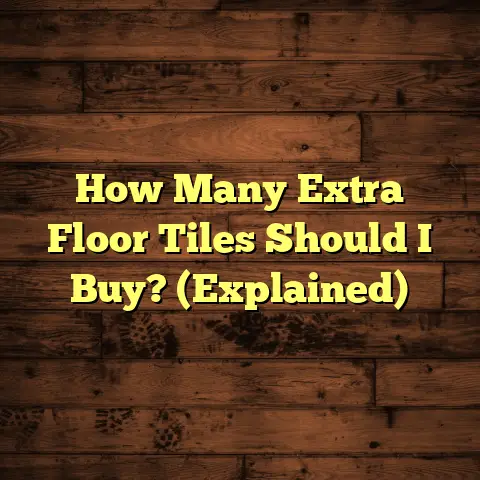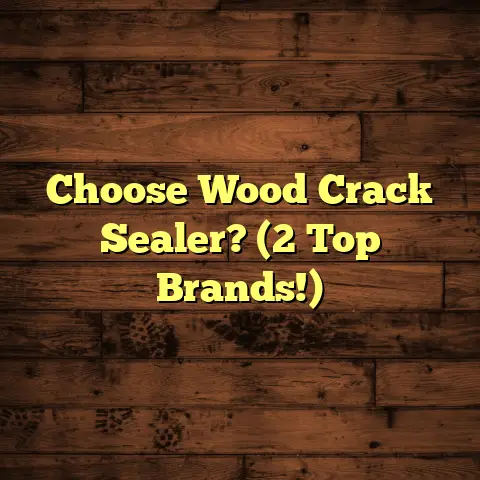Clear Coat on Cement Floors? (2 Pro Secrets!)
Clear Coat on Cement Floors? Ever noticed how cement floors are popping up everywhere these days?
From trendy lofts to minimalist homes, they’re the go-to for a modern, industrial vibe.
But let’s be real, bare cement can be a bit…blah.
That’s where clear coating comes in.
Think of it as the ultimate makeover for your concrete.
It’s not just about looks, though.
A clear coat can seriously transform your floor, adding a layer of protection and making it way easier to live with.
Now, you might be thinking, “Clear coat? Sounds simple enough.”
And while the basic idea is straightforward, there’s a whole world of benefits and tricks that most people miss.
I’m talking about hidden advantages like super-charged durability, stain resistance that’ll save you headaches, and a maintenance routine that’s practically effortless.
Trust me, I’ve seen it all in my years as a flooring contractor.
And I’m here to let you in on a few secrets.
In this article, I’m going to reveal two pro secrets that will help you unlock the full potential of clear-coated cement floors.
These aren’t just tips; they’re game-changers.
Ready to dive in and discover how to take your cement floor from drab to fab?
Let’s get started!
Section 1: Understanding Clear Coating
So, what exactly is clear coating?
Simply put, it’s a transparent layer applied over your cement floor to protect and enhance its appearance.
Think of it like a shield against the daily wear and tear that can quickly dull and damage bare concrete.
There are several types of clear coats available, each with its own set of pros and cons.
Here’s a quick rundown:
- Epoxy: Known for its incredible durability and chemical resistance.
Ideal for high-traffic areas like garages and commercial spaces.
However, it can be more challenging to apply and may yellow over time if not properly UV protected. - Polyurethane: Offers excellent abrasion resistance and flexibility.
Great for residential spaces as it’s less prone to cracking and provides a beautiful, glossy finish.
It’s also UV resistant, preventing yellowing. - Acrylic: A more budget-friendly option that’s easy to apply and provides decent protection.
Best suited for low-traffic areas and DIY projects.
However, it’s not as durable as epoxy or polyurethane and may require more frequent reapplication.
The Application Process
Applying a clear coat isn’t as simple as slapping on a coat of paint.
It’s a multi-step process that requires careful preparation and attention to detail.
Here’s a general overview:
- Preparation: This is the most crucial step.
The floor must be thoroughly cleaned and any cracks or imperfections repaired.
Grinding the surface to create a slightly rough texture is often necessary to ensure proper adhesion. - Application: The clear coat is typically applied in thin, even layers using a roller, brush, or sprayer.
The number of coats required will depend on the product and desired level of protection. - Curing: This is the time it takes for the clear coat to fully harden and reach its maximum durability.
Curing times can vary from a few hours to several days, depending on the product and environmental conditions.
DIY vs. Professional Installation
Now, you might be tempted to tackle this project yourself.
And for smaller, low-traffic areas, a DIY approach can be perfectly fine.
However, for larger or high-traffic areas, I always recommend hiring a professional. Here’s why:
- Expertise: Professionals have the knowledge and experience to choose the right clear coat for your specific needs and apply it correctly.
- Equipment: They have access to specialized equipment like concrete grinders, industrial-grade vacuums, and professional sprayers, which can significantly improve the quality of the finish.
- Time Savings: Let’s be honest, clear coating a floor can be time-consuming and labor-intensive.
Hiring a professional frees up your time and allows you to focus on other things. - Warranty: Most professional installers offer a warranty on their work, giving you peace of mind knowing that any issues will be taken care of.
Common Misconceptions
Let’s bust a few myths about clear coating:
- “It’s too expensive.” While the initial cost may seem high, clear coating can actually save you money in the long run by protecting your floor from damage and reducing the need for repairs.
- “It’s difficult to maintain.” Actually, clear-coated floors are incredibly easy to clean.
A simple sweep and mop are usually all it takes to keep them looking their best. - “It looks fake.” Not at all!
A good clear coat will enhance the natural beauty of the concrete, giving it a subtle sheen without looking artificial.
Section 2: Hidden Benefits of Clear Coating
Okay, let’s get to the good stuff.
We’ve talked about the basics of clear coating, but what are the real benefits?
The ones that most people don’t even realize exist?
Here are a few hidden advantages that will make you wonder why you didn’t clear coat your cement floor sooner:
Increased Durability: This is a big one.
A clear coat acts as a protective barrier against all sorts of abuse.
Think about it: foot traffic, dropped objects, heavy furniture… all of these things can slowly wear down bare concrete.A clear coat adds a layer of defense that can significantly extend the life of your floor.
I’ve seen floors that were clear-coated 10 years ago still look as good as new, while untreated floors in similar conditions were showing signs of wear and tear after just a few years.
* Stain Resistance: Ever spilled red wine on a concrete floor?
Trust me, it’s not a pretty sight.
Concrete is porous, which means it soaks up liquids like a sponge.A clear coat seals the surface, preventing stains from penetrating the concrete and making cleanup a breeze.
I once had a client who accidentally spilled an entire bottle of grape juice on their clear-coated floor.
They were horrified, but to their surprise, the juice wiped right up without leaving a trace.
* Moisture Protection: Moisture is the enemy of concrete.
It can seep into the pores, causing cracks, spalling (flaking), and even mold growth.A clear coat helps to seal the surface, reducing moisture absorption and preventing these problems.
This is especially important in basements and other areas prone to dampness.
According to the Portland Cement Association, properly sealed concrete can last up to 50 years longer than unsealed concrete in wet environments.
* Aesthetic Enhancement: Okay, this one isn’t exactly “hidden,” but it’s worth emphasizing.
A clear coat can dramatically enhance the natural beauty of cement.It can bring out the subtle variations in color and texture, giving the floor a richer, more polished look.
Depending on the type of clear coat you choose, you can achieve a matte, satin, or glossy finish.
I personally love the look of a high-gloss epoxy clear coat, which gives the floor a sleek, modern appearance.
* Cost-Effectiveness: This is where things get really interesting.
While the initial cost of clear coating may seem like an investment, it can actually save you money in the long run.Think about it: by protecting your floor from damage, you’re reducing the need for repairs and replacements.
You’re also saving on cleaning supplies, as clear-coated floors are much easier to maintain.
According to a study by the Concrete Reinforcing Steel Institute, the lifecycle cost of a properly maintained concrete floor is significantly lower than that of other flooring materials like tile or carpet.
Section 3: Pro Secret #1: Choosing the Right Clear Coat
Alright, time to spill the first pro secret!
And it’s a big one: choosing the right clear coat is absolutely critical.
Not all clear coats are created equal.
Using the wrong product can lead to a whole host of problems, from peeling and cracking to yellowing and staining.
So, how do you choose the right clear coat for your specific needs?
Here’s a breakdown of the different types of clear coats and their ideal use cases:
Epoxy: As I mentioned earlier, epoxy is the king of durability.
It’s incredibly strong, chemical-resistant, and can withstand heavy traffic.Ideal for: Garages, workshops, commercial spaces, and any area that needs maximum protection.
Application: Typically requires a two-part mixing process and can be applied with a roller or squeegee.
Benefits: Excellent durability, chemical resistance, high-gloss finish.
Drawbacks: Can be more expensive and challenging to apply, may yellow over time if not UV protected.
* Polyurethane: Polyurethane offers a great balance of durability and flexibility.
It’s less prone to cracking than epoxy and provides a beautiful, glossy finish.Ideal for: Residential spaces, living rooms, bedrooms, and any area where aesthetics are a priority.
Application: Typically a single-part product that can be applied with a roller or brush.
Benefits: Excellent abrasion resistance, UV resistance, beautiful finish.
Drawbacks: Not as chemical-resistant as epoxy, may require more frequent reapplication in high-traffic areas.
* Acrylic: Acrylic is the budget-friendly option.
It’s easy to apply and provides decent protection, but it’s not as durable as epoxy or polyurethane.Ideal for: Low-traffic areas, DIY projects, and situations where cost is a major concern.
Application: Typically a single-part product that can be applied with a roller or brush.
Benefits: Easy to apply, low cost, water-based.
Drawbacks: Not as durable as epoxy or polyurethane, may require more frequent reapplication.
Factors to Consider
When choosing a clear coat, consider these factors:
- Intended Use: Is the space a high-traffic area like a garage, or a low-traffic area like a bedroom?
- Foot Traffic: How much foot traffic will the floor be subjected to?
- Desired Finish: Do you want a matte, satin, or glossy finish?
- Budget: How much are you willing to spend on the clear coat?
- Environmental Conditions: Is the space prone to moisture or extreme temperatures?
Examples
Here are a few examples of scenarios where specific clear coats would be advantageous:
- Scenario 1: A homeowner wants to clear coat their garage floor to protect it from oil spills and heavy traffic.
Recommendation: Epoxy clear coat. - Scenario 2: A homeowner wants to clear coat their living room floor to enhance its appearance and protect it from scratches.
Recommendation: Polyurethane clear coat. - Scenario 3: A homeowner wants to clear coat their basement floor on a tight budget.
Recommendation: Acrylic clear coat.
Section 4: Pro Secret #2: Mastering the Application Process
Okay, you’ve chosen the right clear coat. Now what?
Time for pro secret number two: mastering the application process.
Even the best clear coat will fail if it’s not applied correctly.
I’ve seen countless DIY projects go wrong because people skipped steps, used the wrong tools, or ignored the manufacturer’s instructions.
So, let’s break down the application process step-by-step:
Surface Preparation: This is the most important step.
The floor must be clean, dry, and free of any contaminants.- Cleaning: Start by sweeping or vacuuming the floor to remove any loose debris.
Then, scrub the floor with a concrete cleaner and a stiff brush.
Rinse thoroughly and allow to dry completely. - Repairing: Fill any cracks or imperfections with a concrete patching compound.
Allow to dry and sand smooth. - Grinding (Optional): Grinding the surface with a concrete grinder will create a slightly rough texture that will improve adhesion.
This is especially important for epoxy clear coats. - Etching (Alternative to Grinding): For smaller areas or DIY projects, you can use an etching solution to prepare the surface.
Follow the manufacturer’s instructions carefully. - Mixing (If Applicable): If you’re using a two-part epoxy clear coat, mix the components according to the manufacturer’s instructions.
Use a drill with a mixing attachment to ensure thorough blending. -
Application: Apply the clear coat in thin, even layers using a roller, brush, or sprayer.
-
Roller: Use a high-quality roller with a short nap.
Overlap each pass by about 50% to ensure even coverage. - Brush: Use a brush for edging and hard-to-reach areas.
- Sprayer: A sprayer can provide the most even finish, but it requires more skill and experience.
- Drying: Allow the clear coat to dry completely according to the manufacturer’s instructions.
This may take several hours or even days, depending on the product and environmental conditions. - Second Coat (Optional): For added protection and durability, apply a second coat of clear coat.
Follow the same application and drying instructions as the first coat.
- Cleaning: Start by sweeping or vacuuming the floor to remove any loose debris.
Environmental Conditions
The environmental conditions during application can significantly affect the outcome.
- Temperature: Most clear coats should be applied at temperatures between 60°F and 80°F.
- Humidity: High humidity can slow down the drying process and cause the clear coat to blush or cloud.
- Ventilation: Ensure adequate ventilation to prevent the buildup of fumes.
Troubleshooting Tips
Here are a few common issues that may arise during application and how to fix them:
- Bubbles: Bubbles can occur if the clear coat is applied too thick or if the surface is not properly prepared.
To fix bubbles, use a squeegee to pop them or apply a thin coat of clear coat over the affected area. - Uneven Finish: An uneven finish can occur if the clear coat is not applied evenly or if the surface is not properly prepared.
To fix an uneven finish, sand the affected area and apply another coat of clear coat. - Peeling: Peeling can occur if the clear coat is not properly bonded to the surface.
This is often caused by poor surface preparation.
To fix peeling, remove the peeling clear coat and prepare the surface properly before applying another coat.
Conclusion
So, there you have it!
The secrets to clear coating cement floors like a pro.
We’ve covered everything from the hidden benefits of clear coating to the importance of choosing the right product and mastering the application process.
I hope this article has inspired you to consider clear coating as a viable option for enhancing your cement floors.
It’s a simple yet effective way to protect your investment, improve the aesthetics of your space, and make your life a little bit easier.
Remember, choosing the right product and mastering the application process are key to achieving the best results.
Don’t be afraid to ask for help from a professional if you’re not comfortable tackling the project yourself.
With the right knowledge and tools, you can transform your cement floors into a stunning and durable surface that you’ll enjoy for years to come.
So go ahead, take action and upgrade your flooring today! You won’t regret it.





